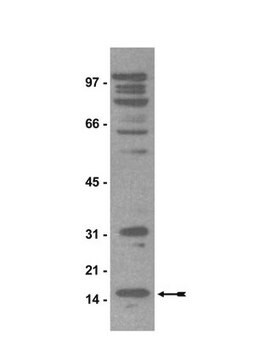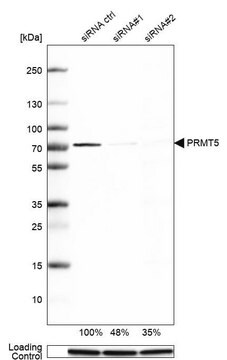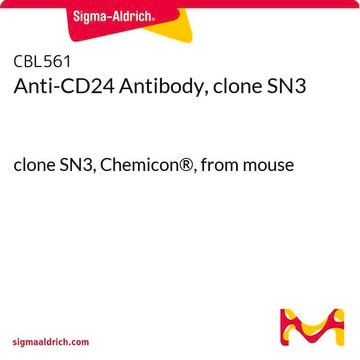07-405
Anti-PRMT5 Antibody
Upstate®, from rabbit
Sinónimos:
72 kDa ICln-binding protein, HMT1 hnRNP methyltransferase-like 5, Jak-binding protein 1, SKB1 homolog, SKB1 homolog (S. pombe), Shk1 kinase-binding protein 1 homolog, protein arginine methyltransferase 5, skb1 (S. pombe) homolog
About This Item
Productos recomendados
origen biológico
rabbit
Nivel de calidad
forma del anticuerpo
purified immunoglobulin
tipo de anticuerpo
primary antibodies
clon
polyclonal
reactividad de especies
mouse, human
fabricante / nombre comercial
Upstate®
técnicas
immunoprecipitation (IP): suitable
western blot: suitable
isotipo
IgG
Nº de acceso NCBI
Nº de acceso UniProt
Condiciones de envío
wet ice
modificación del objetivo postraduccional
unmodified
Información sobre el gen
human ... PRMT5(10419)
Descripción general
Especificidad
Inmunógeno
Aplicación
An independent laboratory has reported that this antibody immunoprecipitates active PRMT5 from HeLa cell lysate.
Epigenetics & Nuclear Function
Histones
Calidad
Western Blot Analysis:
0.5-1 μg/mL of this lot detected PRMT5 in RIPA lysates from 3T3/A31, NIH 3T3, HeLa, WI-38, and Jurkat cells.
Descripción de destino
Ligadura / enlace
Forma física
Almacenamiento y estabilidad
Handling Recommendations: Upon receipt, and prior to removing the cap, centrifuge the vial and gently mix the solution. Aliquot into microcentrifuge tubes and store at -20°C. Avoid repeated freeze/thaw cycles, which may damage IgG and affect product performance. Note: Variability in freezer temperatures below -20°C may cause glycerol containing solutions to become frozen during storage.
Nota de análisis
Jurkat cell lysate, HeLa cell lysate.
Included Positive Antigen Control:
Catalog # 12-303, Jurkat lysate. Add 2.5 μL of 2- mercaptoethanol/100 μL of lysate and boil for 5 minutes to reduce the preparation. Load 20 μg of reduced lysate per lane for minigels.
Otras notas
Información legal
Cláusula de descargo de responsabilidad
Not finding the right product?
Try our Herramienta de selección de productos.
Opcional
Código de clase de almacenamiento
10 - Combustible liquids
Clase de riesgo para el agua (WGK)
WGK 1
Certificados de análisis (COA)
Busque Certificados de análisis (COA) introduciendo el número de lote del producto. Los números de lote se encuentran en la etiqueta del producto después de las palabras «Lot» o «Batch»
¿Ya tiene este producto?
Encuentre la documentación para los productos que ha comprado recientemente en la Biblioteca de documentos.
Nuestro equipo de científicos tiene experiencia en todas las áreas de investigación: Ciencias de la vida, Ciencia de los materiales, Síntesis química, Cromatografía, Analítica y muchas otras.
Póngase en contacto con el Servicio técnico








